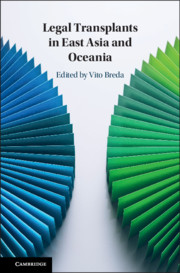Book contents
- Legal Transplants in East Asia and Oceania
- Legal Transplants in East Asia and Oceania
- Copyright page
- Dedication
- Contents
- Figures
- Tables
- Contributors
- Acknowledgements
- Table of Cases
- Table of Statutes
- Abbreviations
- Introduction
- Part I
- Part II
- Part III
- 10 Shark Sanctuaries as Vehicles for Transplanting Conservation Tools in Disparate Legal Jurisdictions
- 11 Global Norms; Local Resistance: Addressing Impunity in Japan and Beyond
- 12 Legal Transplants, Temporary Migration Projects and Special Rights
- Conclusion
- Index
- References
11 - Global Norms; Local Resistance: Addressing Impunity in Japan and Beyond
from Part III
Published online by Cambridge University Press: 18 June 2019
- Legal Transplants in East Asia and Oceania
- Legal Transplants in East Asia and Oceania
- Copyright page
- Dedication
- Contents
- Figures
- Tables
- Contributors
- Acknowledgements
- Table of Cases
- Table of Statutes
- Abbreviations
- Introduction
- Part I
- Part II
- Part III
- 10 Shark Sanctuaries as Vehicles for Transplanting Conservation Tools in Disparate Legal Jurisdictions
- 11 Global Norms; Local Resistance: Addressing Impunity in Japan and Beyond
- 12 Legal Transplants, Temporary Migration Projects and Special Rights
- Conclusion
- Index
- References
Summary
This chapter analyses the nature of legal changes produced by the anti-impunity norm, an emerging doctrine in international law. As its name would suggest, the anti-impunity norm seeks to ensure that perpetrators of human rights violations and serious international crimes, such as genocide, crimes against humanity and war crimes, do not evade accountability for their actions. Relatedly, it also seeks to ensure that victims of rights violations and international crimes enjoy access to justice and suitable reparations, and that societies afflicted with impunity suitably recognize and memorialize past violations. As such, the anti-impunity norm is not only infused with key tenets of international human rights law, international humanitarian law, international criminal law, and transitional justice; it is a deeply political and moral agenda too.
- Type
- Chapter
- Information
- Legal Transplants in East Asia and Oceania , pp. 256 - 296Publisher: Cambridge University PressPrint publication year: 2019
References
IX Bibliography
Cases
International Treaties and Instruments
Japanese Government Sources
Non-Governmental and United Nations Sources
- 1
- Cited by

